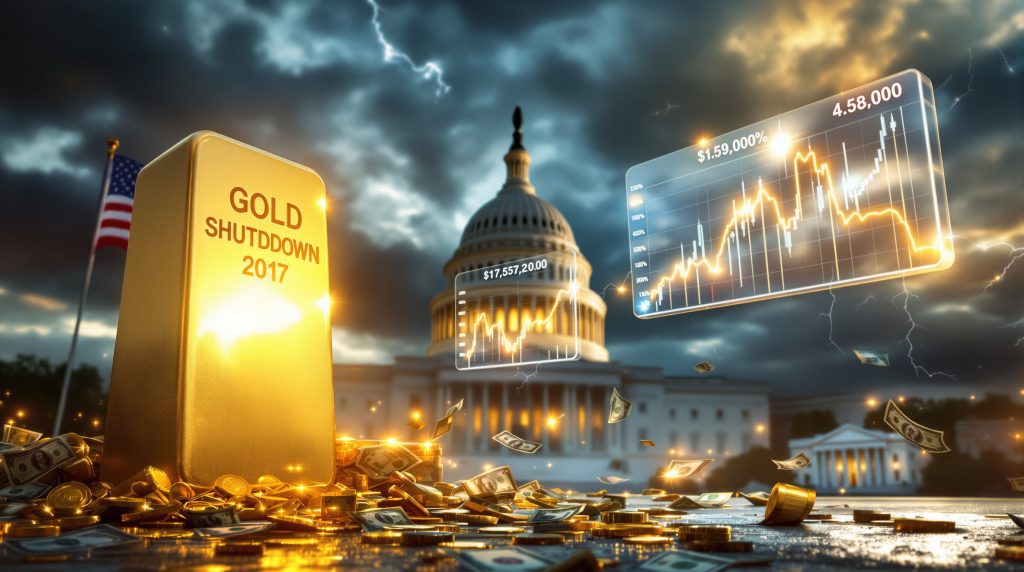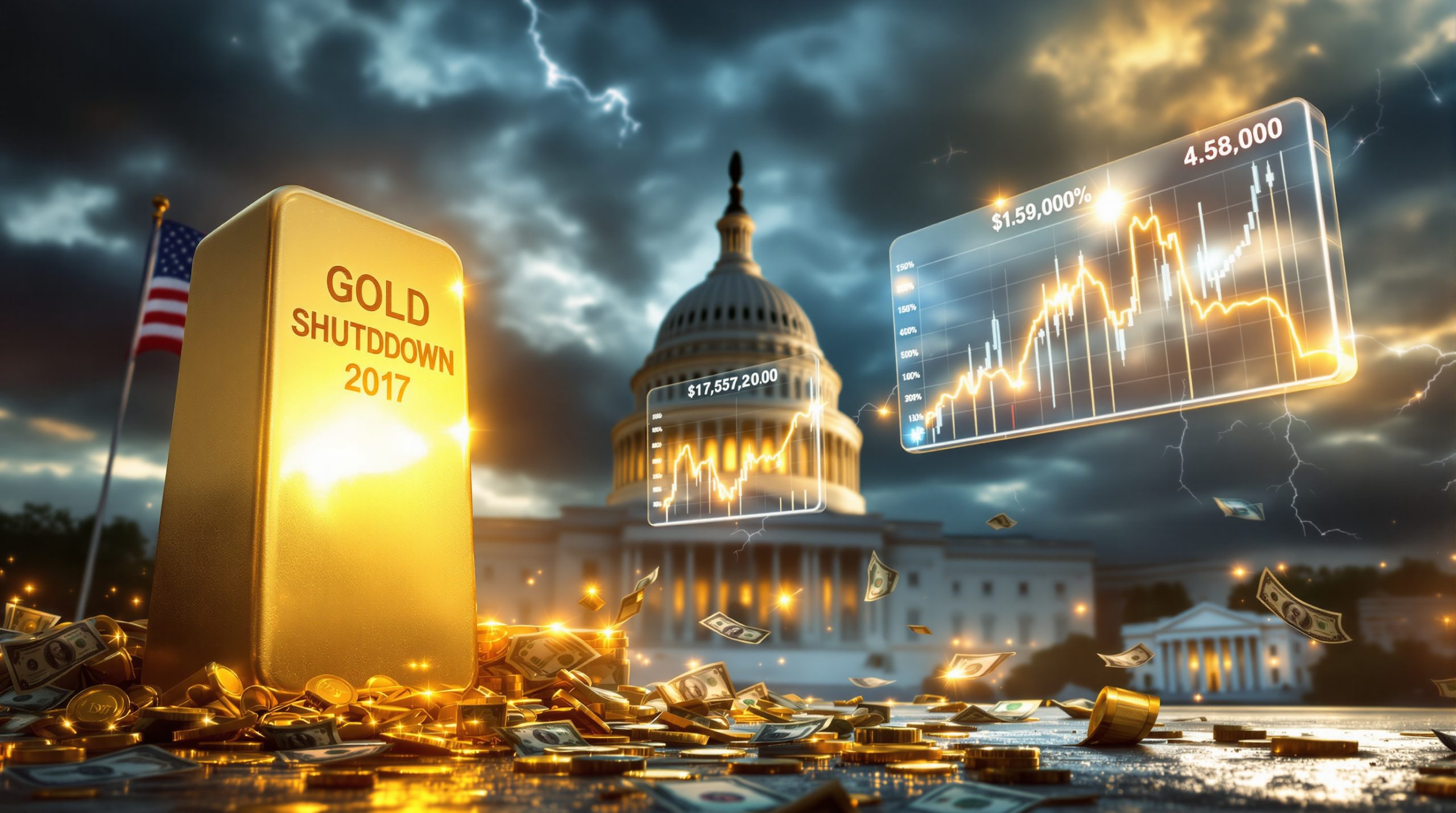Understanding Government Shutdowns and Precious Metals Markets
Federal government shutdowns create immediate ripple effects across financial markets, with us government shutdown impact on gold and silver prices often experiencing heightened volatility during these periods of political uncertainty. When Congress fails to pass appropriations bills, non-essential government services halt, creating a cascade of economic disruptions that investors closely monitor.
The mechanics behind these market movements reveal sophisticated investor behaviour patterns. During the November 2025 government shutdown, precious metals markets demonstrated their classic safe-haven characteristics, with gold climbing more than 5% weekly while silver surged over 11% in the same timeframe. These gains occurred despite initial expectations that shutdown resolution might trigger profit-taking in defensive assets.
The Mechanics of Shutdown Market Impact
Economic data delays represent one of the most significant disruptions during government shutdowns. Federal statistical agencies responsible for collecting and publishing critical economic indicators face operational constraints, creating information gaps that complicate Federal Reserve decision-making processes. The Bureau of Labor Statistics, Census Bureau, and other data-collecting agencies provide the foundation for monetary policy deliberations.
Political uncertainty premiums emerge as institutional and retail investors seek protection from potential economic disruption. This flight-to-safety mentality traditionally benefits tangible assets perceived as stores of value, particularly when fiscal policy concerns accompany the political gridlock.
Dollar weakness often accompanies shutdown periods as markets question government fiscal management capabilities. Since precious metals are priced in dollars, currency weakness typically translates to higher gold and silver valuations across international markets.
Furthermore, market sentiment shifts toward defensive positioning create measurable changes in asset allocation patterns, with precious metals benefiting from reduced confidence in government stability and fiscal responsibility. Gold prices analysis reveals these patterns consistently throughout various market cycles.
Why Do Gold and Silver Prices Rise During Government Shutdowns?
The precious metals market responds predictably to government shutdowns through several interconnected mechanisms that amplify investor demand for tangible assets. These responses reflect both immediate crisis management and longer-term concerns about fiscal sustainability.
Safe-Haven Asset Demand Surge
During political crises, institutional and retail investors traditionally pivot toward assets perceived as stores of value. The November 2025 shutdown exemplified this pattern, with market participants focusing beyond immediate political resolution toward underlying structural fiscal challenges. Rather than treating shutdown resolution as relief, investors maintained precious metals positions based on concerns about ongoing debt trajectory issues.
Central bank buying patterns provide fundamental support beneath precious metals prices regardless of short-term political developments. International monetary authorities have significantly increased gold purchases, creating a supportive floor for precious metals valuations that extends beyond temporary political disruptions. Moreover, this demonstrates the significance of gold strategic investment considerations for portfolio diversification.
Currency Devaluation Concerns
Government shutdowns often signal deeper fiscal challenges, potentially weakening the US dollar's purchasing power. Multi-currency performance data during the November 2025 shutdown revealed important dynamics:
- USD Performance: Gold approached record highs near $4,381.98
- GBP Performance: Silver achieved new all-time high of £41.41 per ounce
- EUR Performance: Gold climbed above €3,600, approaching €3,764.60 record
Key Price Drivers During Shutdowns:
- Increased uncertainty premium in precious metals pricing
- Reduced confidence in government fiscal management
- Delayed economic data creating information gaps
- Potential Federal Reserve policy shifts
Silver's inclusion on the US critical minerals list adds strategic government demand considerations beyond traditional safe-haven positioning, reflecting its dual role as both precious metal and industrial commodity with strategic importance. Consequently, the silver market squeeze dynamics become particularly relevant during political uncertainty periods.
What Was the Impact of the November 2025 Government Shutdown?
The six-week government shutdown that concluded in November 2025 created significant market disruptions, with precious metals experiencing some of their strongest weekly gains in months. The shutdown's resolution was notably not immediately bearish for precious metals, contrary to conventional market expectations.
Immediate Price Movements
| Metal | Pre-Shutdown Price | Peak During Shutdown | Weekly Gain | Record High Referenced |
|---|---|---|---|---|
| Gold (USD) | $3,950/oz | $4,200/oz | 5.2% | $4,381.98 |
| Silver (USD) | $48.50/oz | $54.40/oz | 11.3% | N/A |
| Gold (GBP) | N/A | £3,224/oz | N/A | £3,269.31 |
| Silver (GBP) | N/A | £41.41/oz | New High | £41.41 |
| Gold (EUR) | N/A | €3,600/oz | N/A | €3,764.60 |
| Silver (EUR) | N/A | €46.77/oz | N/A | Near Record |
Multi-Currency Performance Analysis
The shutdown's impact varied across different currency denominations, reflecting regional economic concerns and exchange rate fluctuations. Sterling weakness contributed to silver achieving new all-time highs in GBP terms, while euro-denominated prices approached previous records without breaking through resistance levels.
Market consolidation patterns revealed sophisticated investor positioning. Following October's significant rally and subsequent correction, three weeks of consolidation helped establish stronger technical foundations for renewed precious metals strength. This pattern suggested professional market participants viewed temporary weakness as accumulation opportunities rather than fundamental deterioration signals.
Physical bullion demand indicators showed strain on dealer inventories, with extended delivery timeframes of 2-3 additional days reflecting heightened purchasing interest during the uncertainty period.
How Do Economic Data Delays Influence Federal Reserve Policy?
Government shutdowns disrupt the flow of critical economic indicators that Federal Reserve officials rely upon for monetary policy decisions, creating additional market uncertainty beyond the immediate political crisis.
Critical Data Points Affected
- Monthly employment reports (Non-Farm Payrolls)
- Consumer Price Index (CPI) inflation data
- Gross Domestic Product (GDP) measurements
- Consumer confidence surveys
According to Reuters analysis, "Economic data resumption following shutdown resolution could potentially lead toward Federal Reserve rate reductions if employment market weakness becomes apparent through delayed reporting."
Interest Rate Expectations and Precious Metals
The CME FedWatch tool showed a 55.9% probability of a December rate cut following the shutdown's end, with 44.1% probability for no policy change. This close-call scenario reflected genuine uncertainty about economic conditions during the data blackout period.
Lower interest rate expectations typically benefit gold and silver prices through multiple channels:
- Reducing opportunity costs of holding non-yielding assets
- Weakening the US dollar's relative attractiveness
- Increasing inflation expectations over time
- Encouraging speculative investment in commodities
The December 10th Federal Reserve meeting represented a critical inflection point for precious metals, with rate decision outcomes likely determining whether metals maintained shutdown-driven gains or experienced corrections as political uncertainties resolved. Additionally, understanding gold-silver ratio insights becomes crucial for positioning strategies during such periods.
Market participants positioned for potential economic data surprises upon statistical agency resumption, recognising that accumulated weakness during the shutdown period might justify monetary policy accommodation regardless of political resolution.
What Are the Long-Term Fiscal Implications for Precious Metals?
Beyond immediate shutdown effects, underlying fiscal concerns continue supporting precious metals demand as investors evaluate America's long-term debt trajectory and structural economic challenges.
Debt Sustainability Concerns
Current fiscal metrics highlight systemic challenges that extend beyond temporary political disruptions:
- Federal deficit trends approaching significant GDP percentages
- Rising bond yields reflecting growing fiscal unease
- Proposed spending increases amid revenue constraints
- Mounting interest payments on existing debt obligations
Market analysis suggests investors now focus more on structural fiscal sustainability rather than treating individual shutdowns as discrete crisis events. This maturation in fiscal risk perception indicates institutional positioning for longer-term monetary debasement scenarios.
Central Bank Buying Patterns
International central banks have increased gold purchases significantly, providing fundamental support for precious metals prices regardless of short-term political developments. This institutional demand creates a supportive foundation beneath precious metals valuations that transcends temporary political uncertainty episodes.
Central bank accumulation patterns suggest coordinated efforts to diversify monetary reserves away from traditional currency dependencies, supporting precious metals demand through both crisis periods and economic stability phases. Furthermore, gold price forecast analysis indicates these trends will likely continue throughout 2025.
Strategic mineral classifications for silver add government-level demand considerations that complement traditional monetary demand drivers, creating multiple support channels for sustained precious metals interest.
How Can Investors Position for Future Government Shutdowns?
Understanding historical patterns helps investors develop strategies for navigating shutdown-related market volatility in precious metals markets whilst managing associated risks and timing considerations.
Strategic Considerations for Gold Investment
Timing Opportunities:
- Pre-shutdown positioning during escalating political tensions
- Dollar-cost averaging during extended uncertainty periods
- Profit-taking strategies during peak volatility phases
Risk Management Approaches:
- Diversification across physical and paper gold products
- Geographic diversification through international precious metals
- Position sizing appropriate for portfolio risk tolerance levels
Silver's Unique Dynamics During Political Crises
Silver consistently exhibits greater volatility than gold during shutdown periods, creating both enhanced opportunity and elevated risk profiles. This amplified price behaviour stems from several structural market characteristics:
- Smaller market size creating magnified price movements from equivalent capital flows
- Industrial demand components adding complexity beyond pure monetary considerations
- Higher beta correlation with broader market sentiment fluctuations
- Strategic mineral classification increasing government attention and policy relevance
The November 2025 shutdown demonstrated these dynamics clearly, with silver's 11.3% weekly gain significantly outpacing gold's 5.2% increase during the same timeframe.
Physical silver demand indicators showed particular strength during the shutdown period, with dealer inventory constraints and extended delivery schedules reflecting heightened purchasing interest across retail and institutional market segments.
What Historical Precedents Exist for Shutdown Market Impact?
Previous government shutdowns provide valuable context for understanding precious metals behaviour during political crises, revealing consistent patterns across different political and economic environments.
2013 Shutdown Case Study
The 16-day shutdown in October 2013 demonstrated similar market dynamics to recent events:
- GDP reduction of approximately 0.4% in the fourth quarter
- Temporary gold price increases during peak uncertainty phases
- Market recovery patterns following political resolution
- Federal Reserve policy accommodation supporting metals valuations
Comparative Analysis of Shutdown Effects
| Shutdown Period | Duration | Gold Performance | Silver Performance | Key Factors |
|---|---|---|---|---|
| 2013 | 16 days | +2.8% | +4.1% | Debt ceiling crisis |
| 2018-2019 | 35 days | +1.9% | +3.2% | Border wall funding dispute |
| 2025 | 42 days | +5.2% | +11.3% | Fiscal trajectory concerns |
The November 2025 shutdown demonstrated notably stronger precious metals performance compared to previous episodes, suggesting either escalated fiscal concerns or enhanced market sensitivity to political uncertainty factors.
Pattern analysis reveals consistent themes across shutdown periods: initial safe-haven demand surges, followed by consolidation phases, with resolution outcomes depending on underlying economic fundamentals rather than political agreements alone. However, the us government shutdown impact on gold and silver prices remains significant across all periods.
Duration correlation analysis shows limited relationship between shutdown length and precious metals performance magnitude, indicating that market concerns focus more on fiscal implications than political process disruptions.
Are There Risks to Consider When Investing During Shutdowns?
Whilst government shutdowns often support precious metals prices, investors should understand potential downside scenarios and market risks that could reverse shutdown-driven gains.
Volatility and Timing Risks
Rapid resolution scenarios can trigger immediate profit-taking selloffs as investors who positioned for extended uncertainty face compressed timeframes for defensive positioning benefits.
Economic data surprises upon statistical agency resumption may shift Federal Reserve expectations dramatically, particularly if delayed reports reveal stronger economic conditions than anticipated during the shutdown period.
Dollar strength rebounds can pressure metals pricing if political resolution coincides with positive economic revelations or renewed confidence in government fiscal management capabilities.
Risk-on sentiment returns may reduce safe-haven demand rapidly once political uncertainties resolve and investors rotate toward growth-oriented asset classes.
Market Liquidity Considerations
During shutdown periods, precious metals markets may experience structural changes that affect transaction efficiency and pricing:
- Reduced trading volumes in certain market segments
- Wider bid-ask spreads for physical products reflecting supply constraints
- Delivery delays for bullion purchases due to heightened demand
- Premium fluctuations for coins and bars based on availability concerns
According to Kitco News, "Precious metal prices remain volatile and can decline as rapidly as they rise once political uncertainties resolve and market sentiment shifts toward risk-seeking behaviour."
Physical market constraints during high-demand periods can create temporary pricing dislocations between paper and physical precious metals, requiring careful attention to transaction timing and product selection strategies.
What Should Investors Monitor Moving Forward?
Several key indicators will determine whether precious metals maintain their shutdown-driven gains or experience corrections as political tensions ease and economic fundamentals reassert influence over pricing.
Federal Reserve Policy Signals
- December FOMC meeting outcomes and rate decision implementations
- Economic data interpretation following shutdown resolution and statistical resumption
- Forward guidance on future monetary policy direction and timeline
- Inflation targeting strategy adjustments based on accumulated economic data
Fiscal Policy Development
Congressional budget negotiations and debt ceiling discussions will provide insight into whether the November 2025 shutdown represents isolated political dysfunction or signals deeper structural fiscal challenges requiring sustained precious metals positioning.
Long-term deficit reduction proposals and their political viability will influence investor perceptions about currency debasement risks and the necessity for tangible asset protection strategies.
Tax policy changes affecting economic growth trajectories could alter Federal Reserve policy paths and precious metals demand fundamentals in ways that extend beyond immediate political resolution effects.
Government spending priorities and allocation decisions will reveal whether fiscal discipline emerges from shutdown experiences or whether underlying spending pressures continue supporting precious metals investment themes.
Key Monitoring Points:
- Weekly precious metals positioning reports from CFTC
- Dollar index movements and trend developments
- Bond yield curve dynamics and term structure changes
- International central bank gold purchase data releases
- CME FedWatch tool probability evolution for upcoming meetings
- Physical bullion dealer premium trends and availability indicators
Navigating Precious Metals During Political Uncertainty
Government shutdowns consistently demonstrate their capacity to drive precious metals prices higher through multiple channels of market influence. The November 2025 shutdown exemplified these dynamics, with gold and silver achieving significant gains amid political uncertainty and underlying fiscal concerns that extended beyond immediate crisis resolution.
Market sophistication has evolved to recognise distinctions between temporary political disruptions and structural fiscal challenges. Investor focus on long-term debt sustainability rather than short-term political theatre suggests precious metals positioning reflects strategic portfolio considerations rather than tactical crisis responses.
Successful precious metals investing during shutdown periods requires understanding both immediate safe-haven dynamics and longer-term fiscal implications. Whilst short-term volatility creates opportunities for tactical positioning, investors must balance potential gains against risks associated with rapid political resolution and changing Federal Reserve policy expectations.
The fundamental drivers supporting precious metals extend beyond individual shutdown episodes. Fiscal sustainability concerns, monetary policy uncertainty, and strategic mineral considerations suggest continued relevance for portfolio diversification strategies regardless of specific political outcomes. In particular, the us government shutdown impact on gold and silver prices demonstrates the enduring relationship between political instability and precious metals performance.
Central bank buying patterns provide institutional foundation support for precious metals that transcends temporary political volatility, whilst industrial demand factors for silver add complexity beyond pure monetary positioning considerations. Consequently, understanding the broader implications of us government shutdown impact on gold and silver prices remains essential for informed investment decisions.
Disclaimer: Precious metal prices remain volatile and can decline as rapidly as they rise. Government shutdown impacts on precious metals markets involve speculation about future political and economic developments that may not materialise as expected. This analysis does not constitute investment advice, and readers should conduct independent research and consult financial professionals before making investment decisions. Past performance during previous shutdowns does not guarantee similar outcomes in future political or economic environments.
Ready to Capitalise on Market-Moving Political Events?
Discovery Alert's proprietary Discovery IQ model delivers real-time alerts on significant ASX mineral discoveries, empowering subscribers to identify actionable opportunities as political uncertainty drives precious metals demand and mining sector volatility. Begin your 30-day free trial today to position yourself ahead of market movements and secure your competitive advantage in resource investing.




